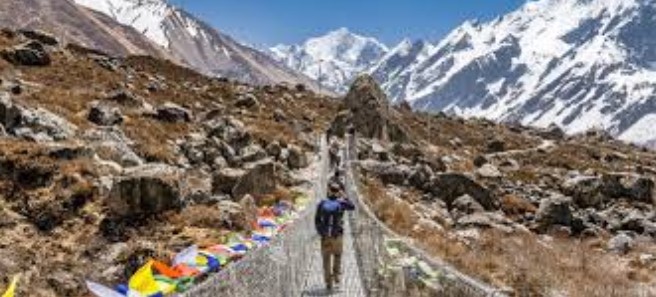Nepal is a land blessed with diverse landscapes, rich cultural traditions, and awe-inspiring Himalayan peaks. Among its most accessible and rewarding trekking regions is Langtang, nestled just north of Kathmandu. Often overshadowed by the Everest and Annapurna regions, Langtang offers a quieter yet equally captivating trekking experience. Within Langtang, three standout treks invite exploration: the Langtang Valley Trek, the Langtang Gosainkunda Trek, and the Langtang Tamang Heritage Trek. Each offers unique vistas, cultural encounters, and varying degrees of challenge—ideal for trekkers of different preferences.
Langtang Valley Trek: A Journey to the Himalayan Heart
The Langtang Valley Trek is a moderate, 7–10 day adventure that takes trekkers through rhododendron forests, traditional villages, and into the high alpine valley surrounded by snow-capped peaks. Beginning typically from Syabrubesi, the trail ascends through Lama Hotel, Ghodatabela, and Langtang Village before reaching Kyanjin Gompa—the spiritual and scenic high point of the trek.
Highlights of Langtang Valley Trek:
- Kyanjin Gompa: A serene Buddhist monastery set against a spectacular mountain backdrop.
- Tserko Ri Hike: An optional day hike from Kyanjin offering panoramic views of Langtang Lirung (7,227 m) and surrounding glaciers.
- Langtang Village: Rebuilt after the 2015 earthquake, this village symbolizes resilience and the strength of local communities.
- Rich Biodiversity: Langtang National Park is home to red pandas, Himalayan tahrs, and diverse birdlife.
Ideal for trekkers seeking a moderate challenge with cultural and natural immersion, the Langtang Valley Trek is a rewarding Himalayan journey without the crowds.
Langtang Gosainkunda Trek: Sacred Lakes and High Passes
For those seeking a spiritual and slightly more challenging adventure, the Langtang Gosainkunda Trek blends dramatic landscapes with pilgrimage significance. This trek usually spans 10–14 days and combines the Langtang Valley with the sacred lakes of Gosainkunda, revered by both Hindus and Buddhists.
Highlights of Langtang Gosainkunda Trek:
- Gosainkunda Lakes: A cluster of alpine lakes set amidst high Himalayan peaks. During Janai Purnima, thousands of pilgrims make the journey here.
- Lauribina La Pass (4,610 m): A thrilling high-altitude crossing offering breathtaking views of the Ganesh and Langtang ranges.
- Chandanbari and Sing Gompa: Famous for cheese production and serene Buddhist monasteries.
- Diverse Trail Experience: The route combines forest trails, alpine meadows, and rugged mountain terrain.
The Langtang Gosainkunda Trek is ideal for trekkers who wish to combine scenic beauty with cultural depth and a dose of high-altitude adventure.
Langtang Tamang Heritage Trek: A Cultural Walk Through Himalayan Villages
If cultural exploration is your primary focus, the Langtang Tamang Heritage Trek offers an enriching experience of Tamang communities. Lasting about 7–10 days, this trek passes through traditional villages like Gatlang, Tatopani, and Thuman, offering warm homestays and firsthand insight into Tamang customs, music, and festivals.
Highlights of Langtang Tamang Heritage Trek:
- Authentic Homestay Experience: Stay in local homes and enjoy traditional Tamang hospitality and cuisine.
- Cultural Immersion: Participate in local dances, rituals, and storytelling.
- Natural Hot Springs at Tatopani: A soothing stop to relax and rejuvenate in the middle of your journey.
- Scenic Landscapes: Panoramic views of Langtang Himal, Ganesh Himal, and Tibetan plateaus.
This trek is perfect for those wanting an off-the-beaten-path experience, connecting closely with the Himalayan people and their centuries-old heritage.
Choosing the Right Langtang Trek for You
Each of these treks has its own flavor. To help you choose, here’s a brief comparison:
| Feature/Trek | Langtang Valley Trek | Langtang Gosainkunda Trek | Langtang Tamang Heritage Trek |
| Duration | 7–10 days | 10–14 days | 7–10 days |
| Max Elevation | Tserko Ri (4,984 m) | Lauribina La (4,610 m) | Nagthali (3,165 m) |
| Trek Difficulty | Moderate | Moderate to Challenging | Easy to Moderate |
| Key Focus | Mountains and Scenery | Sacred Lakes & High Pass | Culture and Local Villages |
| Best Season | Mar-May & Sep-Nov | Mar-May & Sep-Nov | All year (best in spring/autumn) |
| Cultural Immersion | Moderate | Moderate | High |
Planning Your Trek: Essential Tips
- Permits: All treks in the Langtang region require a TIMS card and Langtang National Park entry permit.
- Guides and Porters: While independent trekking is possible, hiring a local guide enhances safety, supports local economy, and enriches cultural understanding.
- Altitude Acclimatization: Though not as high as Everest regions, acclimatization is still crucial, especially on the Gosainkunda route.
- Responsible Travel: Respect local customs, avoid plastic waste, and stay in eco-friendly lodges.
Conclusion: Langtang—A Tapestry of Peaks and People
The Langtang region may be geographically smaller than Annapurna or Everest, but it’s rich in culture, biodiversity, and trekking variety. Whether you’re gazing upon glacial giants in Langtang Valley, reflecting beside the sacred lakes of Gosainkunda, or sharing laughter with Tamang villagers, Langtang leaves a profound impression on those who walk its trails.
Langtang Valley Trek appeals to the mountain lover seeking solitude and dramatic vistas. Langtang Gosainkunda Trek attracts pilgrims and adventure seekers alike. Meanwhile, the Tamang Heritage Trek touches the soul with cultural stories and local warmth.
Whichever path you choose, Langtang is more than a trek—it’s a heartfelt journey into nature, tradition, and the resilience of the human spirit.
Key Takeaways:
- Langtang is a serene and culturally rich trekking region near Kathmandu.
- Langtang Valley Trek is perfect for scenery and moderate adventure.
- Langtang Gosainkunda Trek offers spiritual sites and high-altitude challenges.
- Tamang Heritage Trek delivers deep cultural immersion and off-the-beaten-track appeal.
- Each trek can be done individually or combined for a fuller Langtang experience.
